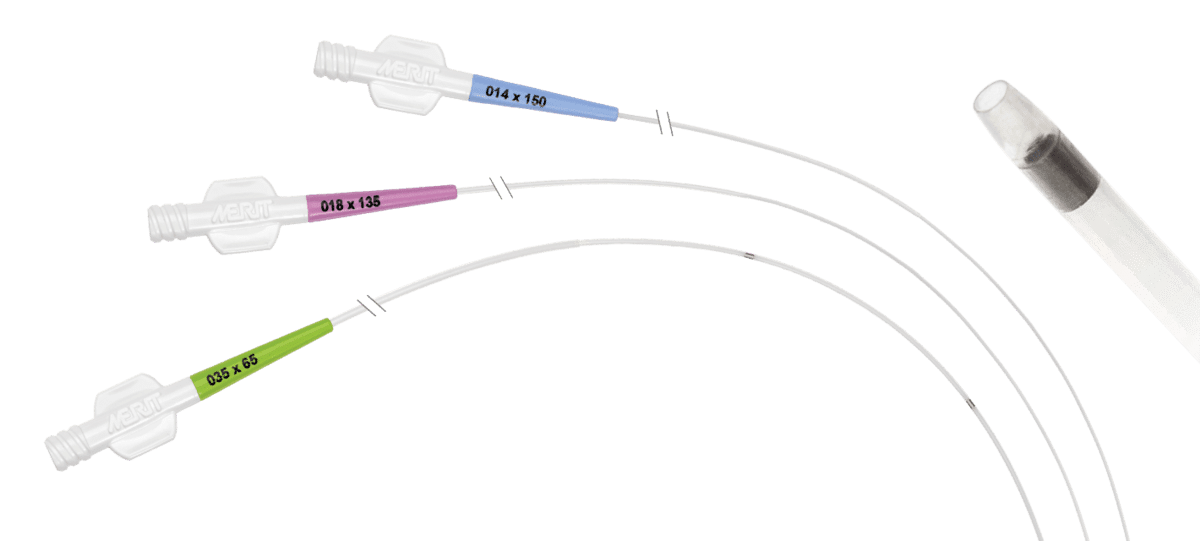INDICATIONS FOR USE
The Merit SureCross Support Catheter is intended for use during coronary and peripheral interventional procedures to guide and support guidewires, traverse discrete portions of the vasculature, allow for guidewire exchanges and provide a conduit for infusion of saline solution, diagnostic contrast agents and therapeutic agents.
WARNINGS
• The Support Catheter is supplied STERILE and for single use only. Do not reprocess or re-sterilize. Reprocessing and re-sterilizing could increase the risk of patient infection and/or compromise device performance.
• The catheter should only be manipulated while observing under fluoroscopy.
• If resistance is encountered at any time during the insertion procedure, do not force passage or torque the catheter. Resistance may cause damage to device or vessel. Carefully withdraw the catheter.
• The catheter should only be advanced or withdrawn over a guidewire.
• Do not exceed the maximum recommended infusion pressure of 300psi.
• This device has not been evaluated for use in the neurovasculature.
PRECAUTIONS
• Preparations should be made and a trained vascular surgical team available in the event conversion to open surgery is required.
• Carefully inspect the package and catheter prior to use to verify no damage occurred during shipment. Do not use if the package or catheter is damaged since the sterility or integrity of the device may be compromised and thus increasing the risk of patient infection and device malfunction.
• To avoid damage to hydrophilic coating, do not wipe the catheter surface with dry gauze.
• To avoid kinking and damaging the catheter, advance slowly in small increments until the proximal end of the guidewire emerges from the catheter.
• To avoid damage to the catheter or vessel, do not advance or withdraw the device without a guidewire in place.
• Do not exceed the maximum recommended infusion pressure of 300 PSI. Higher pressures may cause damage to the catheter and vessels. Refer to Table 2 for flow rates of the catheter.
• Catheter should not be advanced into a vessel having a diameter smaller than the catheter outer diameter. Damage to the vessel or device may occur.
• After use, this product may be a potential biohazard. Handle and dispose of in accordance with acceptable medical practice and applicable local, state, and federal laws and regulations.
• Use the catheter prior to the “Use By” date specified on the package.
PACKAGING, STERILIZATION AND STORAGE
The device has been sterilized using ethylene oxide (EO) and is supplied sterile and non-pyrogenic. The package label indicates the Use By date. Do not use the device after the Use By date. The device sterility and integrity may be compromised and possibly result in patient infection and/or device malfunction. The device should be stored in a cool, dry and dark place. Do not store catheters where they are directly exposed to organic solvents, ionizing radiation, ultraviolet light and high temperatures (greater than 60°C or 140°F). Rotate inventory so that device is used prior to the Use By date on the package label.
RECOMMENDED ITEMS Each Support Catheter package includes the following:
• Single-use sterile disposable catheter contained in a coiled storage tube. Materials required but not provided are:
• 10 ml syringe (filled with sterile heparinized saline)
• One-Way or Three-Way stopcock
• Appropriately sized exchange guidewire
• Appropriately sized hemostatic introducer sheath or guiding catheter
• Additional Support Catheters
• Sterile, heparinized saline (for flushing catheter)
DEVICE PREPARATION
8.1 Carefully inspect the package and catheter prior to use to verify no damage occurred during shipment. Do not use catheter if either the catheter or packaging is damaged or compromised.
8.2 If the packaging is free of damage, carefully open the pouch and introduce the sterile hoop (with catheter) to the sterile field using sterile techniques.
8.3 Carefully disengage the catheter hub from the hoop connector and withdraw the catheter from the hoop. Carefully inspect the catheter for any signs of damage. If damaged, please discard and use another catheter.
8.4 The device is coated with a lubricious hydrophilic coating. Prior to inserting the catheter, activate the coating by immersing the catheter in normal saline for approximately 30 seconds, or wiping down the catheter shaft with a saturated gauze or sponge. Do not wipe the catheter surface with dry gauze.
8.5 Prepare the catheter by removing the air in the catheter lumen. Connect a 10 ml syringe filled with heparinized saline to the hub luer and flush out the lumen. While flushing the catheter, visually inspect the catheter for any signs of damage or leakage. If any damage or leakage is observed, discard and use a new device.
DEVICE USAGE
9.1 Using standard techniques, place the introducer sheath/guiding catheter and guidewire.
9.2 Place the prepared Support Catheter over the previously inserted guidewire by threading the end of the guidewire through the tip of the catheter. Advance the catheter over the guidewire. Refer to Table 1 for guidance regarding appropriate catheter selection along with introducer sheath, guiding catheter and guidewire sizing.
9.3 The catheter can be introduced percutaneously through the introducer sheath or guiding catheter. Do not attempt to pass the device through a smaller sized sheath introducer than indicated.
9.4 Using fluoroscopic imaging, carefully advance the catheter to the desired location in the vasculature. If resistance is encountered at any time during the insertion procedure, do not force passage or torque the device. The markerbands on the distal end of the catheter will provide visual guidance.
9.5 Using fluoroscopic imaging manipulate the guidewire and catheter in order to achieve the desired position. Do not torque the catheter. Also, do not advance or withdraw the catheter without the guidewire in place and extending beyond the distal end of the catheter.
9.6 When removing the catheter, use fluoroscopic imaging and make sure to maintain guidewire position.



